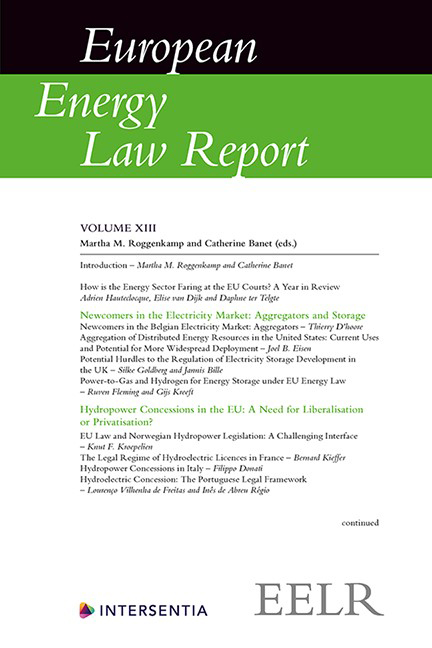Book contents
- Frontmatter
- Preface
- Contents
- List of Abbreviations
- List of Contributors
- Introduction
- Chapter I How is the Energy Sector Faring at the EU Courts? A Year in Review
- PART I NEWCOMERS IN THE ELECTRICITY MARKET: AGGREGATORS AND STORAGE
- PART II HYDROPOWER CONCESSIONS IN THE EU: A NEED FOR LIBERALISATION OR PRIVATISATION?
- PART III INVESTMENTS AND DISINVESTMENTS IN THE ENERGY SECTOR
- PART IV OFFSHORE DECOMMISSIONING IN THE NORTH SEA
- PART V CCS AS A CLIMATE TOOL: NORTH SEA PRACTICE
- PART VI FROM EU CLIMATE GOALS TO NATIONAL CLIMATE LAWS
Chapter XVII - Decommissioning Practice in Norway
Published online by Cambridge University Press: 30 April 2020
- Frontmatter
- Preface
- Contents
- List of Abbreviations
- List of Contributors
- Introduction
- Chapter I How is the Energy Sector Faring at the EU Courts? A Year in Review
- PART I NEWCOMERS IN THE ELECTRICITY MARKET: AGGREGATORS AND STORAGE
- PART II HYDROPOWER CONCESSIONS IN THE EU: A NEED FOR LIBERALISATION OR PRIVATISATION?
- PART III INVESTMENTS AND DISINVESTMENTS IN THE ENERGY SECTOR
- PART IV OFFSHORE DECOMMISSIONING IN THE NORTH SEA
- PART V CCS AS A CLIMATE TOOL: NORTH SEA PRACTICE
- PART VI FROM EU CLIMATE GOALS TO NATIONAL CLIMATE LAWS
Summary
INTRODUCTION
This chapter aims to put decommissioning on the Norwegian Continental Shelf (NCS) into a historic and factual perspective. In addition it intends to present the basic regulatory framework governing decommissioning and to provide some comments on the future of decommissioning on the NCS. It is thus not its purpose to present and review the details of Norwegian decommissioning law.
The chapter is structured as follows: section 2 starts with a brief overview of the history of oil and gas exploration and production on the NCS and also provides some facts and figures with regard to decommissioning. This is followed in section 3 by an introduction to Norwegian decommissioning law, which includes public law and the contractual regime between licensees. Finally, section 4 will provide some thoughts on the future of decommissioning on the NCS.
DECOMMISSIONING ON THE NCS: BRIEF HISTORIC AND FACTUAL BACKGROUND
Petroleum activities started on the NCS in 1965 with the award of the first production licences. The first discovery was made early in 1967, but it was not until the end of 1969 that the first commercial discovery was made. This was the Ekofisk-field, which started producing in 1972 and which is still producing. Since then more than 1000 production licences have been awarded, of which approximately 600 are still active today. There are 41 companies holding licence interests in these licences.
Even if less than half the expected recoverable resources on the NCS have been produced, the NCS is a mature petroleum province. Currently there are around 85 fields producing, as well as some 8000 km of gas export pipelines. There are close to 500 installations on the NCS, and among these are 12 concrete installations, 23 steel floating installations and 59 steel installations resting on the seabed. In addition, there are close to 400 subsea installations. The 12 concrete installations represent approximately 70 per cent of the total weight of all installations on the NCS. Many of these installations are approaching the end of their expected lifetime. However, production and installation lifetime has in many cases been extended substantially due to the tie-in of satellite fields and improved recovery.
- Type
- Chapter
- Information
- European Energy Law Report XIII , pp. 351 - 366Publisher: IntersentiaPrint publication year: 2020



